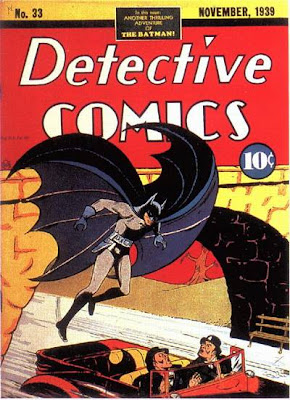Cover by Bob Kane
It kicks off with Batman's origin story: coming home from a movie, Bruce Wayne's parents are killed by a mugger. He vows to rid the world of crime, trains himself physically and mentally, and is inspired by a bat flying through his window. All the major points are covered, although there are a lot of details left to fill in. We don't learn who the mugger is, for example, or what movie the Waynes had just seen. A lot of the iconography, such as Martha's pearls, isn't present. But it's a well executed origin as written by Bill Finger, and gives Batman something besides an awesome costume.
Batman also really comes into his own as a scientist here. We see him mixing chemicals and using all sorts of gadgets, from the batarang to the batplane to a variety of gas pellets. This Batman is very recognisable in comparison to the modern version.
The story ends with an image of Batman posing with a gun, and I've often heard it said that Batman used a gun in his early stories. So far that's only been true once, and then it was to shoot vampires with silver bullets. I'll be keeping an eye on Batman's gun use to see if it's actually a sort of comic book urban myth.
'Spy' (by Jerry Siegel and Mart Bailey): When the fake European nation of Luxen is annexed by the equally fake Thoria, its president escapes to America. Bart must protect him from assassination, and when he returns to Luxen he also helps him incite the citizens to resist their oppressors. The conclusion is fairly unconvincing: the Thorians are holding an election for Luxen people to vote on whether they want to be annexed, and apparently just by voting against this the nation is freed. That's really not how these sorts of things work.
'Buck Marshall, Range Detective' (by Homer Fleming): The Acme Mining Syndicate wants to buy a mine that has suddenly struck it rich, but Buck and the sheriff are suspicious. It turns out that the mine owner is using a syringe to inject the ore samples with gold particles so that he can sell his worthless mine for big bucks. This one has a novel premise, and isn't too bad at all.
'Larry Steele, Private Detective' (by Ken Ernst): Larry investigates a series of jade thefts from a department store. It turns out that one of the managers is the culprit, in a story where the information needed to solve the mystery is only revealed at the end (something I hate in mystery stories). It's not all bad though. Larry's hard-as-nails secretary Brenda is introduced, and she adds a much-needed second dimension to his personality. I think she can accurately be described as a "sassy dame".
'Coffee-Colored Diamonds' (by Frank Thomas): An FBI agent goes to Brazil to expose a diamond smuggler who is hiding the gems inside coffee beans. It gets the job done.
'Speed Saunders Ace Investigator and the Northwoods Mystery' (by Fred Guardineer): Speed goes hunting in Canada, and ends up fighting against a crazy guy who is killing and stealing fur from other hunters. This was okay despite the very high Mountie presence.
'Cosmo, the Phantom of Disguise' (by Sven Elven): Cosmo captures a gang of bank robbers who have tunneled through the sewers to commit their crimes. It's an average story brought even lower by some cliched criminal stupidity.
'Bruce Nelson' (by Tom Hickey): While hunting big game in the Congo, Bruce Nelson is captured by tribesmen and told that he'll be sacrificed to their "White Goddess". It ends with one of those cliffhangers where the protagonist stares in amazement at something we can't see, which is always terrible. But the rest of the set-up is done pretty well.
'Slam Bradley' (by Jerry Siegel and Mart Bailey): Slam and Shorty rescue an heiress and her guardian Farnsby from gangsters who want to steal her $500,000 diamond. Hijinks ensue when Shorty eats the diamond by mistake, and all sorts of crazy characters come by to try and get it out of him. As it turns out, Farnsby is behind the whole thing, and he pocketed the diamond himself and lied about Shorty swallowing it. In terms of the writing it's just as entertaining as ever, but with Mart Bailey on pencils instead of Joe Shuster there's an inevitable drop in quality. If this is the end of the Siegel/Shuster collaboration on this strip I'll be very disappointed. It's been the best run I've read on a Golden Age strip so far.


No comments:
Post a Comment